steering wheel MERCEDES-BENZ SL ROADSTER 2008 Owners Manual
[x] Cancel search | Manufacturer: MERCEDES-BENZ, Model Year: 2008, Model line: SL ROADSTER, Model: MERCEDES-BENZ SL ROADSTER 2008Pages: 317, PDF Size: 5.35 MB
Page 12 of 317
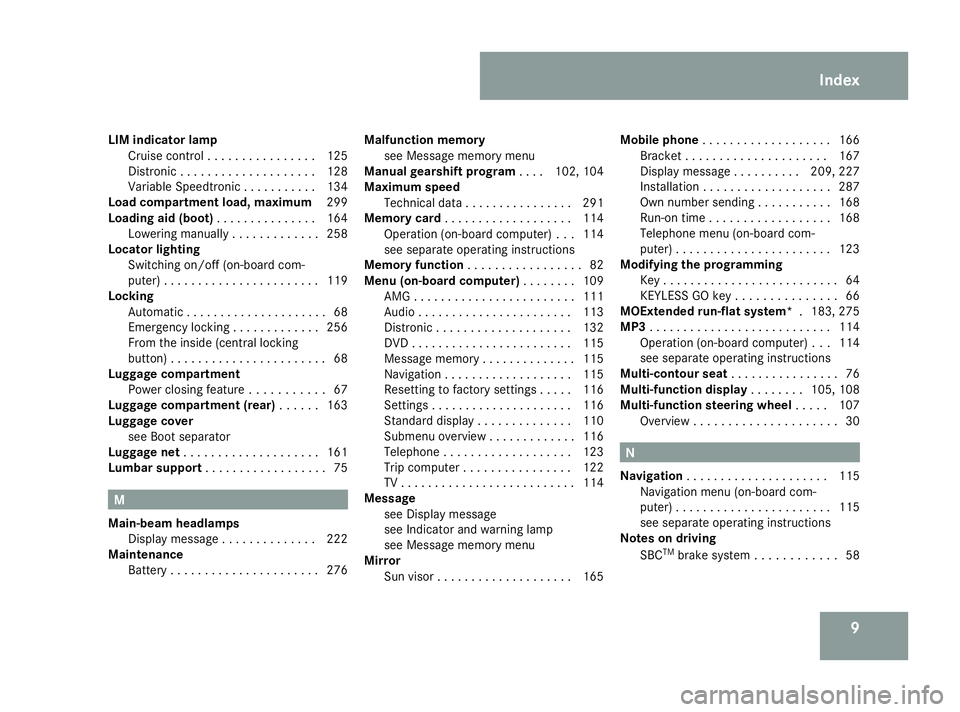
9
LIM indicator lamp
Cruise control ................ 125
Distronic .................... 128
Variabl eSpeedtronic ........... 134
Load compartment load, maximum 299
Loading aid (boot) ............... 164
Lowering manually .............258
Locator lighting
Switching on/off (on-board com-
puter) ....................... 119
Locking
Automatic ..................... 68
Emergency locking .............256
From the insid e(central locking
button) ....................... 68
Luggage compartment
Powe rclosing feature ........... 67
Luggage compartmen t(rear) ...... 163
Luggage cover see Boot separator
Luggage net .................... 161
Lumbar support .................. 75M
Main-beam headlamps Display message .............. 222
Maintenance
Battery ...................... 276Malfunction memory
see Message memory menu
Manual gearshift program ....102, 104
Maximum speed Technical data ................ 291
Memory card ................... 114
Operation (on-board computer) ...114
see separate operating instructions
Memory function ................. 82
Menu (on-board computer) ........109
AMG ........................ 111
Audi o....................... 113
Distronic .................... 132
DVD ........................ 115
Message memory .............. 115
Navigation ................... 115
Resetting to factory settings .....116
Settings ..................... 116
Standard displa y.............. 110
Submenu overview .............116
Telephone ................... 123
Trip computer ................ 122
TV .......................... 114
Message
see Display message
see Indicator and warning lamp
see Message memory menu
Mirror
Sun viso r.................... 165Mobile phone
................... 166
Bracket ..................... 167
Display message ..........209, 227
Installatio n................... 287
Own numbe rsending ........... 168
Run-on time .................. 168
Telephone menu (on-board com-
puter) ....................... 123
Modifying the programming
Key .......................... 64
KEYLESS GO key ............... 66
MOExtended run-flat system* .183, 275
MP3 ........................... 114
Operation (on-board computer) ...114
see separate operating instructions
Multi-contour seat ................ 76
Multi-function display ........105, 108
Multi-functio nsteering wheel .....107
Overview ..................... 30 N
Navigation ..................... 115
Navigation menu (on-board com-
puter) ....................... 115
see separate operating instructions
Notes on driving
SBC TM
brake system ............ 58 Index
230_AKB; 5; 4, en-GB
bjanott,
Version: 2.9.6 2008-04-08T15:09:54+02:00-Seite 9 Dateiname: 6515_3089_02_buchblock.pdf; preflight
Page 15 of 317
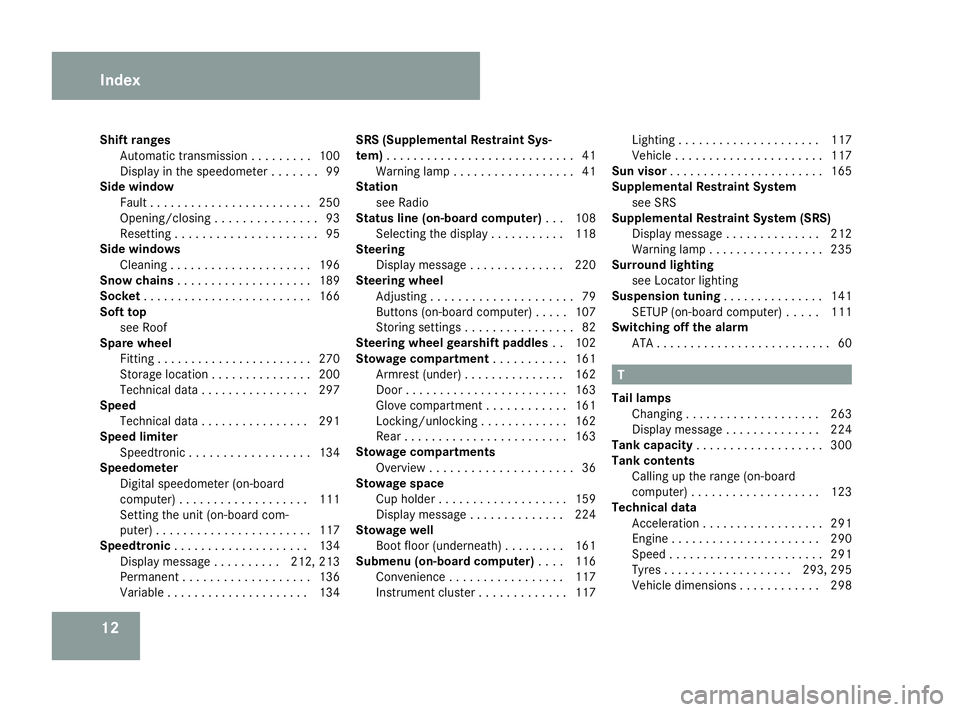
12
Shift ranges
Automatic transmission .........100
Display in the speedometer .......99
Side window
Fault ........................ 250
Opening/closing ............... 93
Resetting .................... .95
Side windows
Cleaning ..................... 196
Sno wchains .................... 189
Socket ......................... 166
Soft top see Roof
Spare wheel
Fitting ....................... 270
Storage location ............... 200
Technical data ................ 297
Speed
Technical data ................ 291
Spee dlimiter
Speedtronic .................. 134
Speedometer
Digita lspeedometer (on-board
computer) ................... 111
Setting the unit (on-board com-
puter) ....................... 117
Speedtronic .................... 134
Display message ..........212, 213
Permanent ................... 136
Variabl e..................... 134SRS (Supplemental Restrain
tSys-
tem) ............................ 41
Warning lamp .................. 41
Station
see Radio
Status line (on-board computer) ...108
Selecting the displa y...........118
Steering
Display message .............. 220
Steering wheel
Adjusting ..................... 79
Buttons (on-board computer) .....107
Storing settings ................ 82
Steering wheel gearshift paddles ..102
Stowage compartment ...........161
Armrest (under) ............... 162
Door ........................ 163
Glove compartment ............161
Locking/unlocking .............162
Rea r........................ 163
Stowage compartments
Overview ..................... 36
Stowage space
Cup holde r.................. .159
Display message .............. 224
Stowage well
Boot floo r(un derneath) ......... 161
Submen u(on-board computer) ....116
Convenience ................. 117
Instrument cluster .............117Lighting
..................... 117
Vehicle ...................... 117
Sun visor ....................... 165
Supplemental Restrain tSystem
see SRS
Supplemental Restrain tSyste m(SRS)
Display message .............. 212
Warning lamp ................. 235
Surround lighting
see Locator lighting
Suspensio ntuning ............... 141
SETUP (on-board computer) .....111
Switchin goff the alarm
ATA .......................... 60 T
Tail lamps Changing .................... 263
Display message .............. 224
Tank capacity ................... 300
Tank contents Calling up the range (on-board
computer) ................... 123
Technical data
Acceleration .................. 291
Engine ...................... 290
Speed ....................... 291
Tyres ................... 293, 295
Vehicle dimensions ............298 Index
230_AKB; 5; 4, en-GB
bjanott,
Version: 2.9.6 2008-04-08T15:09:54+02:00-Seite 12 Dateiname: 6515_3089_02_buchblock.pdf; preflight
Page 22 of 317
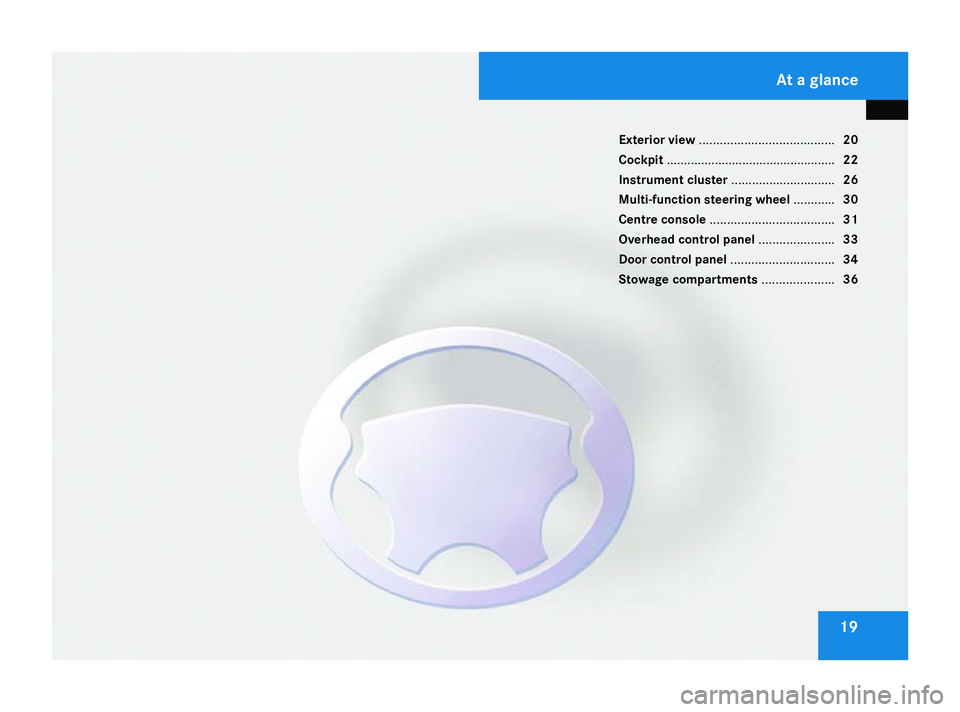
19
Exterior view
....................................... 20
Cockpit ................................................. 22
Instru ment cluster .............................. 26
Multi-function steering wheel ............30
Centre console .................................... 31
Overhead contro lpanel...................... 33
Door contro lpanel.............................. 34
Stowage compart ments ..................... 36 At
ag lance
230_AKB
;5;4,en-GB
bjanott ,V ersion:2.9.6
2008-04-08T15:09:54+02:00
-Seite 19 Dateiname: 6515_3089_02_buchblock.pdf; preflight
Page 26 of 317
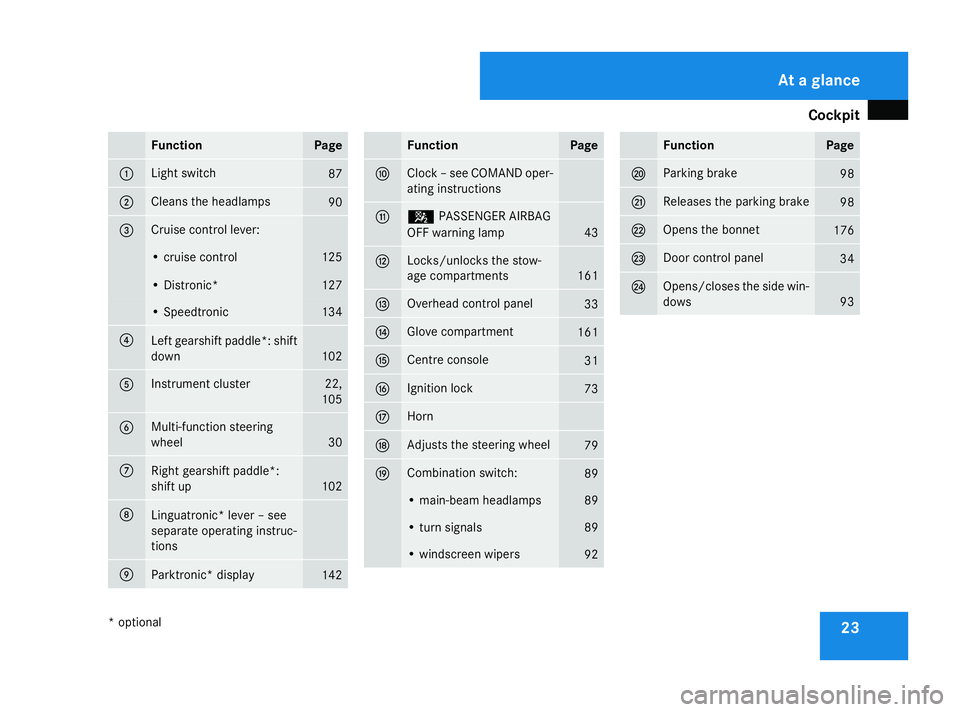
Cockpit
23Function Page
1 Light switch
87
2 Clean
sthe headlamps 90
3 Cruis
econtro llever: •c
ruise control 125
•D
istronic* 127
•S
peedtronic 134
4
Lef
tgearshif tpaddle *: shift
down 102
5 Instrumen
tcluster 22,
105 6 Multi-function steering
wheel
30
7
Right gearshift paddle*:
shift up
102
8
Linguatronic
*lever –see
separat eoperating instruc-
tions 9
Parktronic
*display 142 Function Page
a Clock
–see COMAND oper-
atin ginstructions b 5
PASSENGER AIRBAG
OFF warnin glamp 43
c Locks/unlocks the stow-
age compartments
161
d Overhead control panel
33
e Glove compartment
161
f Centre console
31
g Ignition lock
73
h Horn
j Adjusts the steerin
gwheel 79
k Combination switch:
89
•m
ain-beam headlamps 89
•t
urns ignals 89
•w
indscreen wipers 92 Function Page
l Parking brake
98
m Releases the parking brake
98
n Open
sthe bonnet 176
o Doo
rcontrol panel 34
p Opens/closes the side win-
dows
93At
ag lance
*o ptional
230_AKB; 5; 4, en-GB
bjanott
,V ersion: 2.9.6
2008-04-08T15:09:54+02:00
-Seite 23 Dateiname: 6515_3089_02_buchblock.pdf; preflight
Page 28 of 317
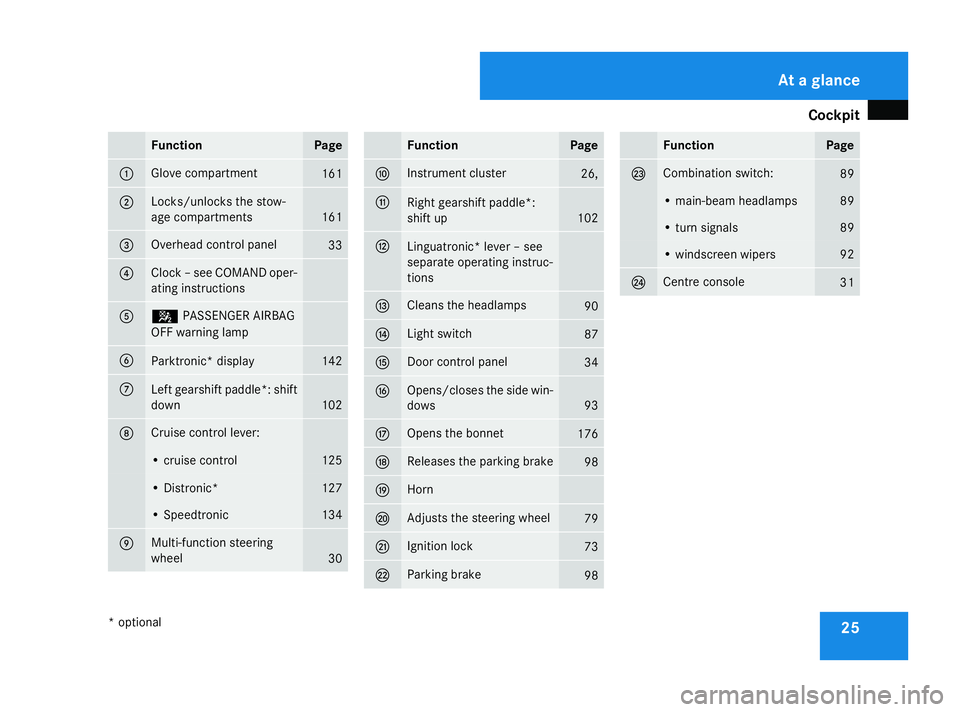
Cockpit
25Function Page
1 Glov
ecom partment 161
2 Locks/unlocks th
estow-
age compartments 161
3 Overhead control panel
33
4 Cloc
k–s ee COMAND oper-
ating instructions 5 5
PASSENGER AIRBAG
OF Fw arning lamp 6
Parktronic* display 142
7
Lef
tgearshif tpaddle *: shift
down 102
8 Cruise control lever:
•c
ruise control 125
•D
istronic* 127
•S
peedtronic 134
9 Multi-function steering
wheel
30 Function Page
a Instrumen
tcluster 26,
b
Right gearshift paddle*:
shift up 102
c
Linguatronic
*lever –see
separat eoperating instruc-
tions d Cleans the headlamps
90
e Light switch
87
f Doo
rcontrol panel 34
g Opens/closes the side win-
dows
93
h Open
sthe bonnet 176
j Releases the parking brake
98
k Horn
l Adjusts the steerin
gwheel 79
m Ignition lock
73
n Parking brake
98 Function Page
o Combination switch:
89
•m
ain-beam headlamps 89
•t
urns ignals 89
•w
indscreen wipers 92
p Centre console
31At
ag lance
*o ptional
230_AKB; 5; 4, en-GB
bjanott
,V ersion: 2.9.6
2008-04-08T15:09:54+02:00
-Seite 25 Dateiname: 6515_3089_02_buchblock.pdf; preflight
Page 33 of 317
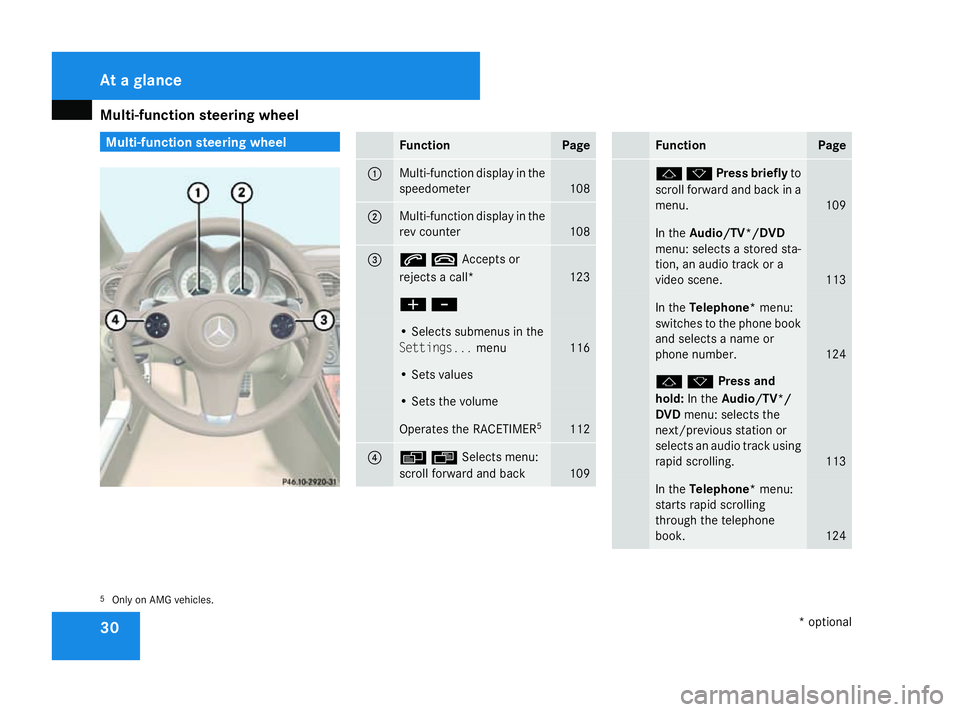
Multi-function steering wheel
30 Multi-function steering wheel
Function Page
1 Multi-function display in the
speedometer
108
2 Multi-function display in the
rev counter
108
3 st
Accepts or
rejects acall* 123
æ
- •S
elect ssubme nusint he
Settings... menu 116
•S
etsv alues •S
etst he volume Operates the
RACETIMER5 112
4 èÿ
Selects menu:
scrol lforward an dback 109 Function Page
jk
Press briefly to
scroll forward and back in a
menu. 109
In the
Audio/TV*/DVD
menu: selects astored sta-
tion, an audio track or a
video scene. 113
In the
Telephone* menu:
switches to the phone book
and selects aname or
phone number. 124
jk
Press and
hold: In the Audio/TV*/
DVD menu: selects the
next/previous station or
selects an audio track using
rapids crolling. 113
In the
Telephone* menu:
starts rapids crolling
through the telephone
book. 124
5 Only on AMG vehicles. At
ag lance
*optional
230_AKB; 5; 4, en-GB
bjanott, Version: 2.9.6 2008-04-08T15:09:54+02:00-Seite 30 Dateiname: 6515_3089_02_buchblock.pdf; preflight
Page 43 of 317
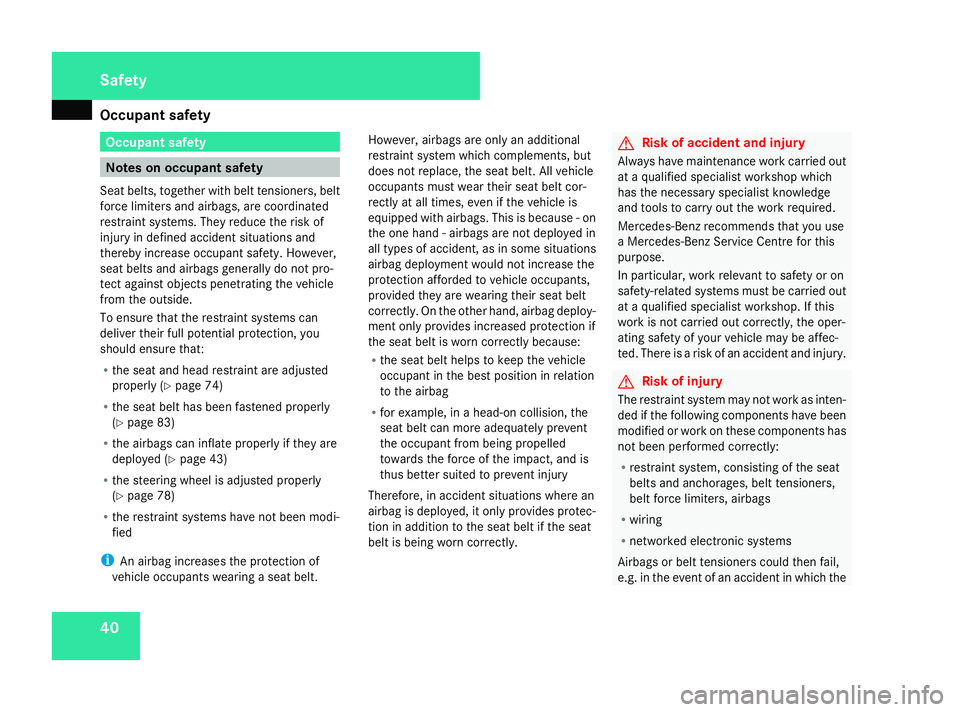
Occupant safety
40 Occupant safety
Notes on occupant safety
Seat belts, together with belt tensioners ,belt
forc elimiters and airbags, are coordinated
restraint systems .They reduce the risk of
injury in defined acciden tsituation sand
thereby increase occupant safety. However,
seat belts and airbags generally do not pro-
tec tagainst objects penetratin gthe vehicle
from the outside.
To ensure that the restraint systems can
deliver their full potential protection ,you
should ensure that:
R the seat and head restraint are adjusted
properly (Y page 74)
R the seat belt has been fastened properly
(Y page 83)
R the airbags can inflat eproperly if they are
deployed (Y page 43)
R the steering wheel is adjusted properly
(Y page 78)
R the restraint systems have not been modi-
fied
i An airbag increases the protection of
vehicle occupants wearing aseat belt. However, airbags are only an additional
restraint system which complements, but
does not replace, the seat belt. All vehicle
occupants must wear their seat belt cor-
rectly at all times, even if the vehicle is
equipped with airbags. This is because
-on
the one hand -airbags are not deployed in
all types of accident, as in some situations
airbag deployment would not increase the
protection afforded to vehicle occupants,
provided they are wearing their seat belt
correctly. On the other hand, airbag deploy-
ment only provides increased protection if
the seat belt is worn correctly because:
R the seat belt helps to keep the vehicle
occupant in the best position in relation
to the airbag
R for example, in ahead-on collision, the
seat belt can more adequately prevent
the occupant from being propelled
towards the forc eofthe impact ,and is
thus better suited to preven tinjury
Therefore, in acciden tsituation swhere an
airbag is deployed, it only provides protec-
tion in addition to the seat belt if the seat
belt is being worn correctly. G
Risk of accident and injury
Always have maintenanc ework carried out
at aq ualified specialist workshop which
has the necessary specialist knowledge
and tools to carry out the work required.
Mercedes-Benz recommends that you use
aM ercedes-Benz Service Centr efor this
purpose.
In particular, work relevant to safety or on
safety-related systems must be carried out
at aq ualified specialist workshop. If this
work is not carried out correctly, the oper-
ating safety of your vehicle may be affec-
ted. There is arisk of an acciden tand injury. G
Risk of injury
The restraint system may not work as inten-
ded if the following component shave been
modified or work on these component shas
not been performed correctly:
R restraint system, consistin gofthe seat
belts and anchorages, belt tensioners,
belt forc elimiters ,airbags
R wiring
R networked electronic systems
Airbags or belt tensioners could then fail,
e.g. in the event of an acciden tinwhich the Safety
230_AKB
;5;4,en-GB
bjanott, Version:2.9.6
2008-04-08T15:09:54+02:0
0-Seite 40 Dateiname: 6515_3089_02_buchblock.pdf; preflight
Page 47 of 317
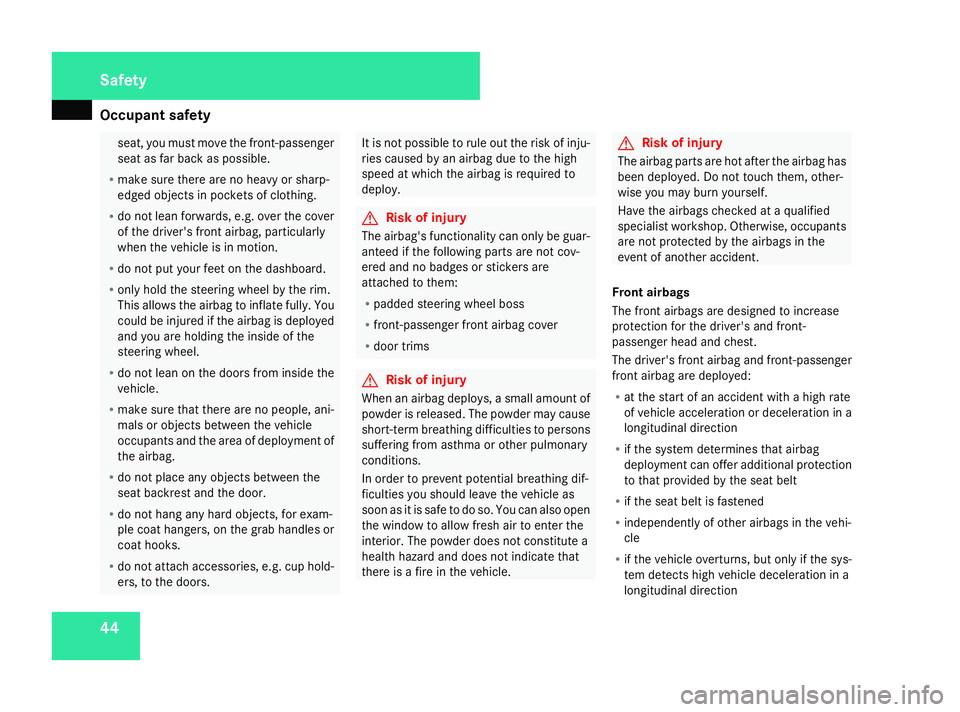
Occupant safety
44 seat, you must move the front-passenger
seat as far back as possible.
R make sure ther eare no heavy or sharp-
edged objects in pockets of clothing.
R do not lean forwards, e.g. over the cover
of the driver's fron tairbag, particularly
when the vehicle is in motion.
R do not put your feet on the dashboard.
R only hold the steering wheel by the rim.
This allows the airbag to inflat efully. You
could be injured if the airbag is deployed
and you are holding the inside of the
steering wheel.
R do not lean on the doors from inside the
vehicle.
R make sure that ther eare no people, ani-
mals or objects between the vehicle
occupants and the area of deployment of
the airbag.
R do not place any objects between the
seat backrest and the door.
R do not hang any hard objects, for exam-
ple coat hangers, on the grab handles or
coat hooks.
R do not attach accessories, e.g. cup hold-
ers, to the doors. It is not possible to rule out the risk of inju-
ries caused by an airbag due to the high
speed at which the airbag is required to
deploy. G
Risk of injury
The airbag's functionality can only be guar-
anteed if the following parts are not cov-
ered and no badges or stickers are
attached to them:
R padded steering wheel boss
R front-passenger fron tairbag cover
R door trims G
Risk of injury
When an airbag deploys, asmall amount of
powder is released. The powder may cause
short-term breathin gdifficulties to persons
sufferin gfrom asthma or other pulmonary
conditions.
In order to preven tpotential breathin gdif-
ficulties you should leave the vehicle as
soon as it is safe to do so. You can also open
the window to allow fresh air to enter the
interior. The powder does not constitute a
health hazard and does not indicat ethat
ther eisaf ire in the vehicle. G
Risk of injury
The airbag parts are hot after the airbag has
been deployed. Do not touch them ,other-
wise you may burn yourself.
Have the airbags checked at aqualified
specialist workshop. Otherwise, occupants
are not protected by the airbags in the
event of another accident.
Front airbags
The fron tairbags are designed to increase
protection for the driver's and front-
passenger head and chest.
The driver's fron tairbag and front-passenger
fron tairbag are deployed:
R at the start of an acciden twith ahigh rate
of vehicle acceleration or deceleration in a
longitudinal direction
R if the system determines that airbag
deployment can offer additional protection
to that provided by the seat belt
R if the seat belt is fastened
R independently of other airbags in the vehi-
cle
R if the vehicle overturns, but only if the sys-
tem detects high vehicle deceleration in a
longitudinal direction Safety
230_AKB
;5;4,en-GB
bjanott, Version:2.9.6
2008-04-08T15:09:54+02:0
0-Seite 44 Dateiname: 6515_3089_02_buchblock.pdf; preflight
Page 48 of 317
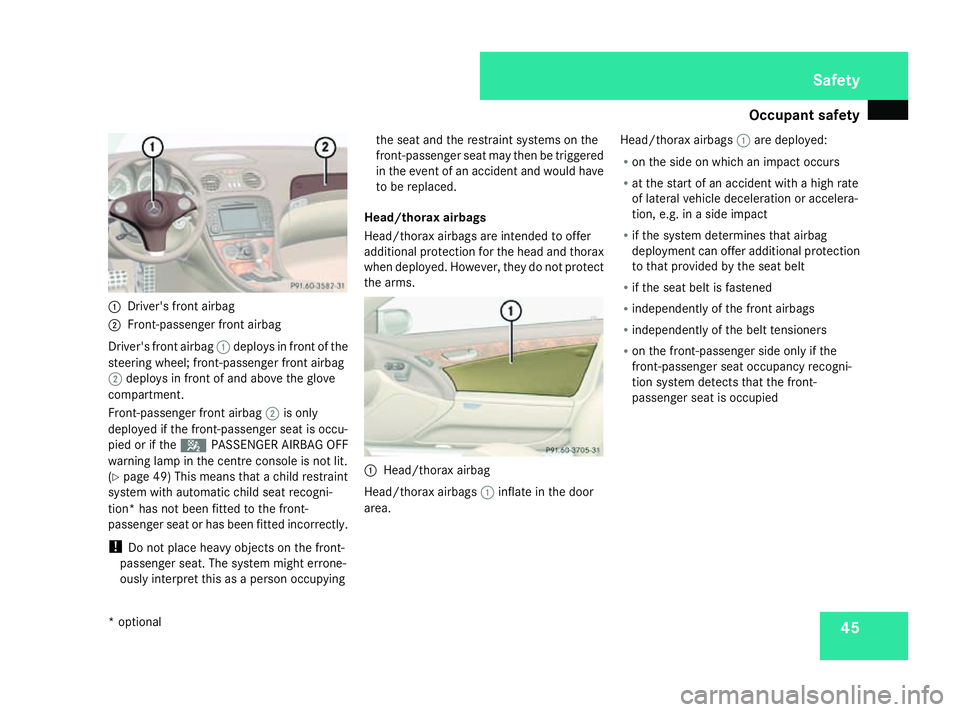
Occupant safety
451
Driver's front airbag
2 Front-passenger front airbag
Driver's front airbag 1deploysinf ront of the
steering wheel; front-passenger front airbag
2 deploysinf ront of and above the glove
compartment.
Front-passenger front airbag 2is only
deployed if the front-passenger seat is occu-
pied or if the 5PASSENGER AIRBAG OFF
warning lamp in the centre console is not lit.
(Y page 49) This means that achild restraint
system with automatic child seat recogni-
tion* has not been fitted to the front-
passenger seat or has been fitted incorrectly.
! Do not place heavy objectsont he front-
passenger seat. The system might errone-
ously interpret this as aperson occupying the seat and the restraint systems on the
front-passenger seat may then be triggered
in the event of an accident and would have
to be replaced.
Head/thoraxa irbags
Head/thorax airbags are intended to offer
additional protection for the head and thorax
when deployed. However, they do not protect
the arms. 1
Head/thorax airbag
Head/thorax airbags 1inflate in the door
area. Head/thorax airbags
1are deployed:
R on the side on which an impact occurs
R at the start of an accident with ahigh rate
of lateral vehicle deceleration or accelera-
tion, e.g. in aside impact
R if the system determines that airbag
deployment can offer additional protection
to that provided by the seat belt
R if the seat belt is fastened
R independently of the front airbags
R independently of the belt tensioners
R on the front-passenger side only if the
front-passenger seat occupancy recogni-
tion system detectst hat the front-
passenger seat is occupied Safety
*o ptional
230_AKB; 5; 4, en-GB
bjanott
,V ersion: 2.9.6
2008-04-08T15:09:54+02:00
-Seite 45 ZDateiname: 6515_3089_02_buchblock.pdf; preflight
Page 56 of 317

Driving safet
ysystems 53Driving safety systems
Overvie
wofdrivingsafety systems
In thi ssection, yo uwillf in di nformation about
the following driving safety systems:
R ABS ( Anti-lock Braking System)
R BAS ( Brake Assist System)
R Adaptive brake lamps
R ESP ®
( Electronic Stability Program)
R SBC TM
brake syste m( Sensotronic Brake
Control)
i In wintry roa dconditions ,alway susewin-
ter tyres (M+ Styres )and ,w here necessary,
sno wchains .Onlyint hisw aywill the driv-
ing safety systems describe dinthiss ection
work as effectivel yaspossible. G
Ris
kofa ccident
Th er iskofana ccident is significantly
increase dbydriving too fast. This is partic-
ularly the case when cornering on we tand
slippery roads and when driving too close
to the vehicl einfront.
Th ed riving safety systems describe dinthis
sectio ncannot reduc ethisr iskn or override
the laws of physics. For thi
sreason, always adap tyou rd riving
style to suit prevailing roa dand weather
conditions .Maintain sufficient distance
fro mo ther roa dusers and objects on the
road. ABS (Anti-lock Braking System)
ABS regulate sbrake pressure in such away
tha tthe wheels do not lock when yo ubrake.
This allows yo utocontinue steering the vehi-
cle when braking.
ABS works fro maspeed of abou t8km/h
upwards ,regardles sofroads urface condi-
tions. ABS works on slippery surfaces ,even
when yo uonlyb rake gently. G
Ris
kofa ccident
Do not depress the brake peda lsev eral
times in quick succession (pumping).
Depres sthe brake firml yand evenly .Pum p-
ing the brake peda lreduces the braking
effect.
Braking If ABS intervenes whil
eyou areb raking ,the
v warning lamp flashe sinthe instrument cluster. Yo
uwilln ot fee lthe brake peda lpul-
sating as thi shappe ns.
X If ABS intervenes: continue to depress the
brake peda lwithf orce unti lthe braking sit-
uatio niso ver.
X To make afullb rak eapplication:
depress the brake peda lwithf ullf orce. G
Ris
kofa ccident
If ABS is faulty, the wheels could lock when
braking .Thisl imit sthe steerability of the
vehicl ewhenb raking and the braking dis-
tanc emayincrease.
If ABS is deactivate dduetoam alfunction,
the nB AS and ESP ar ealsod eact ivated.
There is an increase driskofy ourv ehicle
skidding in certai nsituations.
Yo us houl dalway sadapt your driving style
to suit the prevailing roa dand weather con-
ditions. Safety
230_AKB; 5; 4, en-GB
bjanott,
Version: 2.9.6 2008-04-08T15:09:54+02:00-Seite 53 ZDateiname: 6515_3089_02_buchblock.pdf; preflight